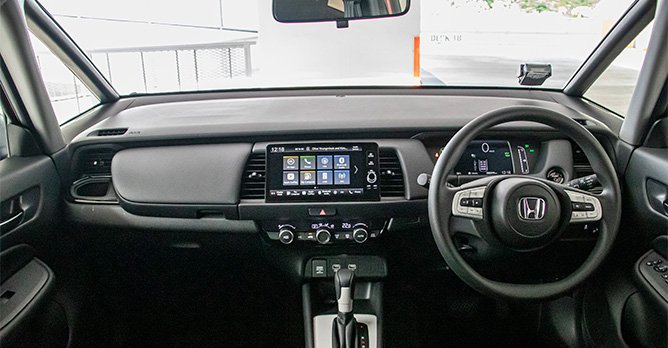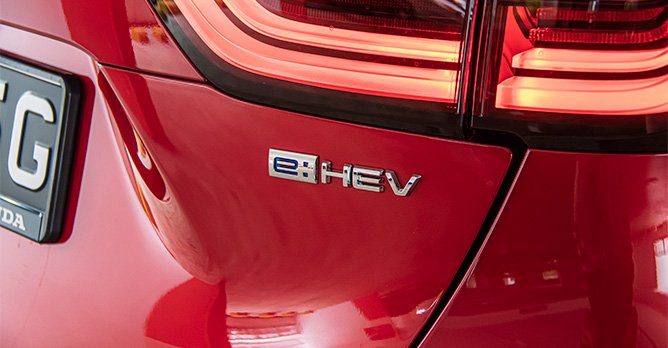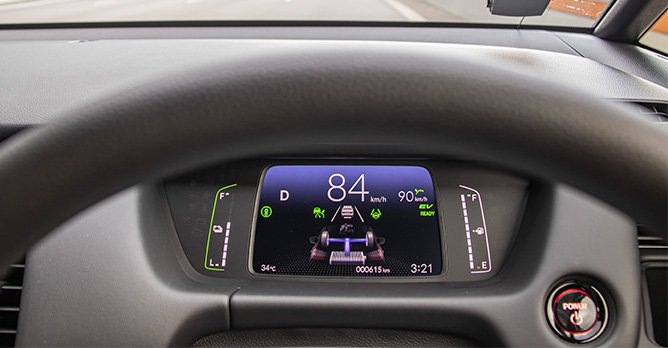Honda Jazz Crosstar Hybrid 1.5 X (A) Review
03 Mar 2023|30,064 views
What We Like
More distinct-looking, even as practical template of Jazz remains
Spacious interior especially in the rear; space configuration also just as versatile
Good efficiency and performance from hybrid drivetrain
Well-equipped
What We Dislike
'Crosstar'-variant enhancements don't add much in terms of utility
Jazz's oddball looks may be amplified to some in SUV-drag
Confronted with growing consumer interest in crossovers, rumours had already swirled back in 2012 that Honda was toying with the idea of a, shall we say, range expansion for its bestselling Fit/Jazz.
Eventually, it did - but the slightly-toughened up concoction, called the Fit Twist, was only given limited release, and made official solely for the Brazilian market.
As is clear for all to see, said consumer interest has been lifted further into the clouds over the past decade. Aware of this fact, and choosing to switch gears now, Honda is finally also opting for a wide release.
What has thus emerged from the Jazz caving to the bite of the crossover-bug is this: A higher riding variant called the Jazz Crosstar, which looks like it could tackle a bit of mud and dirt, but would actually much prefer it if you kept it fully on tarmac.
Blending genres

Especially so because it leans fully into the aesthetic trends that define the crossovers of today.
Plastic cladding adorns the lower bits of the car, from its front and rear bumpers, to its wheel arches, then to its doors, while 'skid plates' make an appearance. It's the sort of rugged-lite image one probably finds in "How to send cars flying out of your showroom doors"-textbooks. Dual-tone paintwork is an option too.
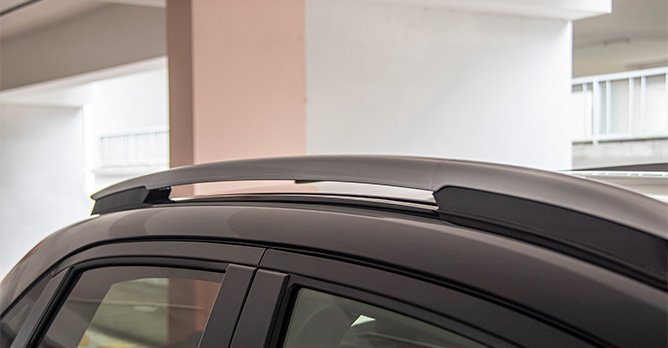
As mentioned, the Crosstar does get a bit more ride height with an extra 11mm of ground clearance, and sits on wheel tracks that have been widened by the exact same length. Even the feeling created isn't 100% crossover-like, however; you'll still have to lower yourself slightly to get into the car, which on the whole, more accurately straddles the more niche midway-point between hatchbacks and crossovers (instinctively, the most recent reference is VW's discontinued CrossPolo).
Nonetheless, the enhancements mean the Crosstar occupies more space in all directions than the Jazz - in terms of width, length and height - and it does have slightly more presence on the road as a result.
Still singing the same tune inside
A familiar space will greet occupants when they settle into the seats of the Crosstar. While trying quite hard to distinguish itself externally, this taller twin relinquishes all that effort by utilising exactly the same interior as the Jazz - which boasts a modern design, and is thoughtfully laid out.
Despite this being a compact and budget-oriented car at its very core, the Crosstar's dash is spruced up by a well-sized (and responsive) 9.0-inch infotainment touchscreen, and solid-feeling switchgear that is satisfying to use. Contrasting tones on its twin-spoke steering wheel, as well as the multitude of display screens on the 7.0-inch digital instrument cluster also give the car a bit of character.
The rear quarters, undeniably, remain the most praiseworthy aspect of the car. While shoulder and legroom are more than acceptable, headroom for passengers feels fantastic for something this size. With a flat floor, even three adults should not find themselves in too much of a squeeze on the second row, and can take turns to charge their phones with two dedicated USB-C points.
Like the Jazz, the Crosstar's boot capacity may not be immediately impressive (a rather shallow space lies between the tailgate and rear bench), but this is mitigated by its above-average height, and the nice, flat bed achieved with the seats folded down.
Above all, carrying over Honda's ULTRA Seats means the Crosstar is still one of the leading names in space versatility - regardless of whether you'd classify it as a compact hatch or a compact crossover.
Efficient (and surprisingly potent) runabout
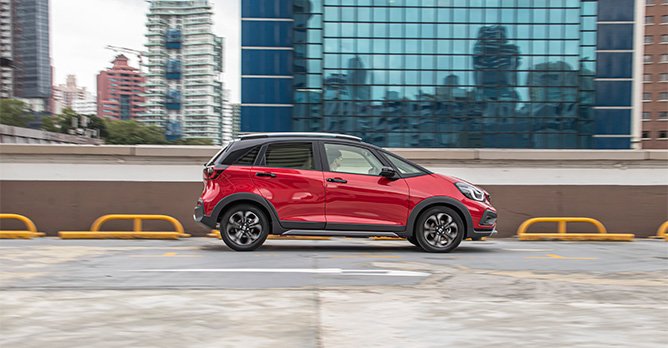
Recent revisions to the drivetrain (first introduced on the pre-facelifted Jazz) now allow its two electric motors and 1.5-litre naturally aspirated engine to arrive at a slightly higher total output of 130bhp.
Worth noting is that this system feels very willing to put the car into EV mode when possible - you move off with pure electric power; the engine kicks in when the car is given enough gas; and the motors are then handed the reins again as you're coasting at higher speeds.
The Crosstar also weighs only 4kg more than the standard Jazz, is still front-wheel driven and thus suffers minimally in terms of rated efficiency. Our 50:50 mixture of highway and city driving amounted to a reassuring consumption figure of nearly 21km/L - which isn't too far off the 22.2km/L quoted by Honda.
On the road, what this means as well is a commendable level of drivetrain refinement alongside a decent amount of shove as the car gets up to speed. Even with five on board, the Crosstar rarely felt like it was lacking in power.
The current-gen Jazz also isn't what one might classify as 'sporty', so the extra ride height in the Crosstar doesn't do much to change the driving experience. What it does offer, however, is the slightest elevation of a driver's view onto the road - which is a quality we suspect the average Jazz buyer might appreciate.
Finally, since the base template of the Jazz is fundamentally unchanged, the Crosstar - with its compact dimensions, good all-round visibility from its large windows, and small turning radius - feels effortless to pilot around our carparks and narrower streets. Driving assistance essentials like adaptive cruise control and lane keeping assist round the package off nicely.
The Jazz range: Keeping abreast with extra breadth
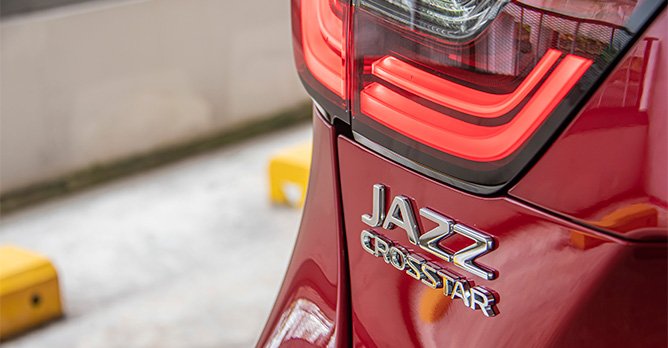
Stuffed within its compact frame are more cupholders and storage spaces than one can imagine, incredible space for the average family, and performance and fuel economy that will easily satisfy most drivers. Historically, reliability has also been its strong suit.
Yet stared at in the face by an increasing field of compact crossovers that have threatenened to do its job almost, or even just as competently, it seems Honda has felt the need for the model to adapt - and the Crosstar is that result.
Considering that not much differentiates it at the very core from the normal Jazz - not utility, efficiency, nor even affordability (the Crosstar surprisingly retails for less than the Jazz at launch) - what will ultimately sway customer decisions is likely to boil down to the style factor. We think the Jazz is complete enough on its own, but if you don't, the Crosstar is an alternative you also can't go wrong with.
On the lookout for other compact crossovers in the market? Don't forget these other options!
Built atop of the same platform as the formidable little Polo, VW's compact T-Cross punches well above its weight
Refreshed with mild hybrid assistance, the Kia Stonic's breadth of practical capabilities expands even further
Ostensibly aimed at younger, bolder drivers, the Yaris Cross impresses with its easy drive and outstanding efficiency
What We Like
More distinct-looking, even as practical template of Jazz remains
Spacious interior especially in the rear; space configuration also just as versatile
Good efficiency and performance from hybrid drivetrain
Well-equipped
What We Dislike
'Crosstar'-variant enhancements don't add much in terms of utility
Jazz's oddball looks may be amplified to some in SUV-drag
Confronted with growing consumer interest in crossovers, rumours had already swirled back in 2012 that Honda was toying with the idea of a, shall we say, range expansion for its bestselling Fit/Jazz.
Eventually, it did - but the slightly-toughened up concoction, called the Fit Twist, was only given limited release, and made official solely for the Brazilian market.
As is clear for all to see, said consumer interest has been lifted further into the clouds over the past decade. Aware of this fact, and choosing to switch gears now, Honda is finally also opting for a wide release.
What has thus emerged from the Jazz caving to the bite of the crossover-bug is this: A higher riding variant called the Jazz Crosstar, which looks like it could tackle a bit of mud and dirt, but would actually much prefer it if you kept it fully on tarmac.
Blending genres

Especially so because it leans fully into the aesthetic trends that define the crossovers of today.
Plastic cladding adorns the lower bits of the car, from its front and rear bumpers, to its wheel arches, then to its doors, while 'skid plates' make an appearance. It's the sort of rugged-lite image one probably finds in "How to send cars flying out of your showroom doors"-textbooks. Dual-tone paintwork is an option too.

As mentioned, the Crosstar does get a bit more ride height with an extra 11mm of ground clearance, and sits on wheel tracks that have been widened by the exact same length. Even the feeling created isn't 100% crossover-like, however; you'll still have to lower yourself slightly to get into the car, which on the whole, more accurately straddles the more niche midway-point between hatchbacks and crossovers (instinctively, the most recent reference is VW's discontinued CrossPolo).
Nonetheless, the enhancements mean the Crosstar occupies more space in all directions than the Jazz - in terms of width, length and height - and it does have slightly more presence on the road as a result.
Still singing the same tune inside
A familiar space will greet occupants when they settle into the seats of the Crosstar. While trying quite hard to distinguish itself externally, this taller twin relinquishes all that effort by utilising exactly the same interior as the Jazz - which boasts a modern design, and is thoughtfully laid out.
Despite this being a compact and budget-oriented car at its very core, the Crosstar's dash is spruced up by a well-sized (and responsive) 9.0-inch infotainment touchscreen, and solid-feeling switchgear that is satisfying to use. Contrasting tones on its twin-spoke steering wheel, as well as the multitude of display screens on the 7.0-inch digital instrument cluster also give the car a bit of character.
The rear quarters, undeniably, remain the most praiseworthy aspect of the car. While shoulder and legroom are more than acceptable, headroom for passengers feels fantastic for something this size. With a flat floor, even three adults should not find themselves in too much of a squeeze on the second row, and can take turns to charge their phones with two dedicated USB-C points.
Like the Jazz, the Crosstar's boot capacity may not be immediately impressive (a rather shallow space lies between the tailgate and rear bench), but this is mitigated by its above-average height, and the nice, flat bed achieved with the seats folded down.
Above all, carrying over Honda's ULTRA Seats means the Crosstar is still one of the leading names in space versatility - regardless of whether you'd classify it as a compact hatch or a compact crossover.
Efficient (and surprisingly potent) runabout

Recent revisions to the drivetrain (first introduced on the pre-facelifted Jazz) now allow its two electric motors and 1.5-litre naturally aspirated engine to arrive at a slightly higher total output of 130bhp.
Worth noting is that this system feels very willing to put the car into EV mode when possible - you move off with pure electric power; the engine kicks in when the car is given enough gas; and the motors are then handed the reins again as you're coasting at higher speeds.
The Crosstar also weighs only 4kg more than the standard Jazz, is still front-wheel driven and thus suffers minimally in terms of rated efficiency. Our 50:50 mixture of highway and city driving amounted to a reassuring consumption figure of nearly 21km/L - which isn't too far off the 22.2km/L quoted by Honda.
On the road, what this means as well is a commendable level of drivetrain refinement alongside a decent amount of shove as the car gets up to speed. Even with five on board, the Crosstar rarely felt like it was lacking in power.
The current-gen Jazz also isn't what one might classify as 'sporty', so the extra ride height in the Crosstar doesn't do much to change the driving experience. What it does offer, however, is the slightest elevation of a driver's view onto the road - which is a quality we suspect the average Jazz buyer might appreciate.
Finally, since the base template of the Jazz is fundamentally unchanged, the Crosstar - with its compact dimensions, good all-round visibility from its large windows, and small turning radius - feels effortless to pilot around our carparks and narrower streets. Driving assistance essentials like adaptive cruise control and lane keeping assist round the package off nicely.
The Jazz range: Keeping abreast with extra breadth

Stuffed within its compact frame are more cupholders and storage spaces than one can imagine, incredible space for the average family, and performance and fuel economy that will easily satisfy most drivers. Historically, reliability has also been its strong suit.
Yet stared at in the face by an increasing field of compact crossovers that have threatenened to do its job almost, or even just as competently, it seems Honda has felt the need for the model to adapt - and the Crosstar is that result.
Considering that not much differentiates it at the very core from the normal Jazz - not utility, efficiency, nor even affordability (the Crosstar surprisingly retails for less than the Jazz at launch) - what will ultimately sway customer decisions is likely to boil down to the style factor. We think the Jazz is complete enough on its own, but if you don't, the Crosstar is an alternative you also can't go wrong with.
On the lookout for other compact crossovers in the market? Don't forget these other options!
Built atop of the same platform as the formidable little Polo, VW's compact T-Cross punches well above its weight
Refreshed with mild hybrid assistance, the Kia Stonic's breadth of practical capabilities expands even further
Ostensibly aimed at younger, bolder drivers, the Yaris Cross impresses with its easy drive and outstanding efficiency
Car Information
Honda Jazz Crosstar Hybrid
CAT A|Petrol-Electric|22.2km/L
Horsepower
97kW (130 bhp)
Torque
-
Acceleration
-
Thank You For Your Subscription.














































